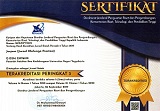ADAPTASI SUHU TUBUH TERHADAP LATIHAN DAN EFEK CEDERA DI CUACA PANAS DAN DINGIN
DOI:
https://doi.org/10.21831/jorpres.v6i2.10339Abstract
Somebody's skill to adapt in their different surrounding environment is differing from one to another; it can be seen in the level of the acclimatization toward the temperature. Today, we have to do our activities or practices in a high temperature, we will lose many body's liquid. From that reason, body will do some of physiologic mechanism to send the heat out and stabilized the body temperature by paying attention and doing efforts to change the body liquid which was out and bring the body's mineral internally pr externally.
Some of injuries which can happen when we do some practices in dry area are heat cramps, heat syncope, heat exhaustion (there are two types: water completing, salt completing), and heat stroke. Many sweats out from the body can cause dehydration.
In the other hand, if we doing some practicing in cold area, the body physiology adaptation is side system velocity decrease, the body will decrease blood pale velocity on the extremity in skin surface. Body's chill setting is an increasing metabolic rapid caused by thyroxin and catecholamine release (epinephrine and nor epinephrine)
Keywords: body's temperature, practice, injury effect, hot and cold weather
Downloads
How to Cite
Issue
Section
License
Authors who publish with this journal agree to the following terms:
- Authors retain copyright and grant the journal right of first publication with the work simultaneously licensed under a Creative Commons Attribution License that allows others to share the work with an acknowledgement of the work's authorship and initial publication in this journal.
- Authors are able to enter into separate, additional contractual arrangements for the non-exclusive distribution of the journal's published version of the work (e.g., post it to an institutional repository or publish it in a book), with an acknowledgement of its initial publication in this journal.
- Authors are permitted and encouraged to post their work online (e.g., in institutional repositories or on their website) prior to and during the submission process, as it can lead to productive exchanges, as well as earlier and greater citation of published work (See The Effect of Open Access).




